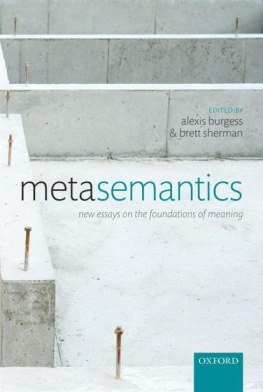All rights reserved. No part of this book may be reproduced in any form by any electronic or mechanical means (including photocopying, recording, or information storage and retrieval) without permission in writing from the publisher.
This book was set in Helvetica and Times Roman by the author. Printed and bound in the United States of America.
Names: Baggio, Giosu, author.
Title: Meaning in the brain / Giosu Baggio.
Description: Cambridge, MA : MIT Press, [2018] | Includes bibliographical references and index.
Identifiers: LCCN 2017055021 | ISBN 9780262038126 (hardcover: alk. paper)
Subjects: LCSH: Meaning (Psychology). | Semantics. | Psycholinguistics.
Implicit in the urge to speak is the quest for meaning, not necessarily the quest for truth.
A success of explanation is a success of adequate and informative description.
The entire brain, more or less, is at work in a man who uses language.
Contents
List of Figures
Illusory Kanizsa triangle.
The binding problem in semantics.
The N400 effect in ERPs relative to the onset (at 0 ms) of the eliciting word. The waveforms display amplitude differences between semantically incongruent (socks) and congruent (butter) words, as in example (1). Reprinted from Kutas and Hillyard (1980) with permission.
Semantic anomaly effects on intracranial ERPs. Numbers denote electrodes. Homologue areas of the left hemisphere showed similar responses. Reprinted from Nobre et al. (1994) with permission.
Subdivision of the left inferior frontal gyrus (LIFG) into pars opercularis (blue), pars triangularis (turquoise), and pars orbitalis (yellow). See Keller et al. (2009) for the complete abbreviation list. Reprinted from Keller et al. (2009) with permission.
Probabilistic reconstruction of white matter connectivity in left perisylvian cortex. A ventral fiber tract (b) connects pars triangularis (F3tri) and pars orbitalis (F3orb) of LIFG to posterior (T2p) and anterior (T2a) temporal regions via the extreme capsule (EmC). There exist direct connections between the fusiform gyrus (FUS; recall the discussion in subsection 2.1.4) and other areas in the ventral temporal pathway. Reprinted from Saur et al. (2008) with permission. Copyright (2008) National Academy of Sciences, U.S.A.
Hierarchy of multiregional convergence zones in the human brain. Reprinted (a) from Damasio (1989) and (b) from Mesulam (2008) with permission. See the original references for the complete abbreviation list.
The semantic system of the brain as reconstructed in a meta-analysis of 120 PET and fMRI studies. Reprinted from Binder et al. (2009) with permission.
Supramodal (red) and modality-specific networks (yellow) in the semantic system. Reprinted from Binder and Desai (2011) with permission.
Compositional and noncompositional neural codes for compound rules. Each cell in an activation grid represents a voxel in a three-dimensional fMRI sampling space. Activation levels are depicted as different shades of gray. Reprinted from Reverberi et al. (2012) with permission.
Anatomy and connectivity of perisylvian networks of the left hemisphere. Brain areas are depicted as labeled circles. Bidirectional white matter connections are shown as arrows. AF is the arcuate fasciculus, EmC is the extreme capsule, IFOF is the inferior fronto-occipital fasciculus, ILF is the inferior longitudinal fasciculus, and UF is the uncinate fasciculus. The somatosensory cortex (SSC), visual cortex (VC), auditory cortex (AC), and motor cortex (MC) are also shown.
The cycle model of R-system function at the implementational level of analysis. Active brain areas are depicted as grayscale circles. Arrows represent current flows between active areas. Each word is processed in one cycle. Context denotes active temporal regions, instantiating a representation of previously processed material. The specifics of each panel, and the meaning of the labels in (c) and (d), are explained in detail in the text.
Brain responses to semantic incongruity as revealed by event-related optical signals (EROS). Word onset is at 0 ms. S/MTC is the superior and middle temporal cortex, overlapping with left pMSTG, and IFC is the left inferior frontal cortex (LIFG). Reprinted from Tse et al. (2007) with permission. Copyright (2007) National Academy of Sciences, U.S.A.
The N400 (left) and SAN (right) effects in the EEG experiment on Dutch progressive constructions by Baggio et al. (2008). These effects were evoked by successive words in the same sentence.
Correlations between brain regions subserving verification of numerical (N) and Aristotelian (A) quantifiers. Bivariate Pearson coefficients are overlaid on brain renderings. Parameter estimates of regional activation are shown as bar plots. Reprinted from Troiani et al. (2009) with permission.
Quantifier comprehension in the brain. (a) Activations to ambiguous doubly quantified sentences compared to unambiguous baseline items. Reprinted from McMillan et al. (2013). (b) Activations to sentences with Aristotelian and numerical (cardinality and majority) quantifiers compared to a precise number baseline. Reprinted from Olm et al. (2014). Both images are available under the Creative Commons Attribution license.
Summary of a meta-analysis of 53 neuroimaging experiments of language processing using stimuli with increased syntactic (blue areas), semantic (red), and pragmatic (orange) demands. Reprinted from Hagoort and Indefrey (2014) with permission.
(chapter 3).
The extended cycle model (eCM) of I-system function at the neural level of analysis. Active cortical areas are depicted as grayscale circles. Arrows represent current flows between active areas. The specifics of each panel (a)(d) are explained in detail in the text.
Processing dynamics in the I-system. (a) A comparison of incremental word (wi) processing rates between sensory systems (word-by-word and higher), the R-system (one processing cycle for each content word), the I-system (one processing cycle for each referring expression), and the E-system (one processing cycle for each signal; chapters 79). (b) Source localization of -band responses to referentially coherent anaphors compared to ambiguous anaphors. Reprinted from Nieuwland and Martin (2017) with permission.
Caravaggio (Michelangelo Merisi), The Cardsharps, c. 1595, oil on canvas, 37 1/1651 9/16 in. (94.2130.9 cm), AP 1987.06, Kimbell Art Museum, Fort Worth, Texas.
Examples of total pooling, partial pooling, and separating equilibrium types in signaling games.
Multigenerational signaling games in diffusion chains in different lineages.
Estimated reconstruction of MEG source activity in response to congruous vs incongruous spoken words relative to a preceding picture in 12- to 18-month-old children. Reprinted from Travis et al. (2011) with permission.







